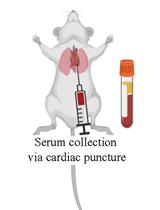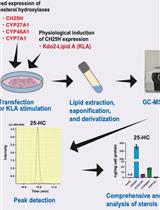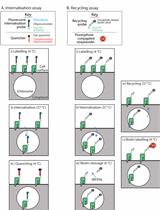- EN - English
- CN - 中文
Determination of Rate of [3H-methyl]-choline Incorporation into Cellular Lipids and Non-lipid Metabolites
[3H-甲基]-胆碱掺入细胞脂质和非脂质代谢物速率的测定
发布: 2016年11月20日第6卷第22期 DOI: 10.21769/BioProtoc.2019 浏览次数: 7725
评审: Neelanjan BoseYong TengCarsten Ade
Abstract
The choline-containing phospholipid, phosphatidylcholine (PtdCho) is the most common mammalian phospholipid found in cell membrane (Ide et al., 2013). It is also a component of intracellular signalling pathways (Cui and Houweling, 2002). Herein is described a measure of the rate of accumulation of choline by lipid soluble PtdCho and lyso-Ptdcho which can further be discriminated by chromatographic analysis (Smith and Phyu, 2016). Determination of the accumulation of [3H-methyl]-choline into water-soluble components is also described. The procedure could be used to measure the effect of drugs and other factors on choline incorporation into phospholipids. After exposure of cells to test conditions (e.g., drugs) adherent cells in tissue culture flasks are incubated with radiolabelled [3H-methyl]-choline in medium for 15 min (pulse). The [3H-methyl]-choline is then rapidly removed and incubation continued in the presence of non-radioactive medium (chase). Cellular distribution of [3H-methyl] is then determined by cell fractionation and measurement of radioactivity in the lipid and non-lipid cellular components.
Background
Phospholipid metabolism is essential in formation of cell membranes (Ide et al., 2013) and cell signalling (Cui and Houweling, 2002). Both the formation of choline-containing metabolites and the accumulation of choline into lipids are pivotal processes during cellular proliferation. Perturbations in phospholipid metabolisms are associated with cancer and other disorders (Gibellini and Smith, 2010). Measurement of these processes is central to understanding medical imaging modalities that detect choline incorporation by tumour tissue using [11C]-choline-PET (positron emission tomography) (Podo et al., 2007) and choline metabolite content using 31P or 1H (proton) magnetic resonance spectroscopy (Saeedi et al., 2005).
Here is described a method of quantitating the incorporation of choline into aqueous and lipid components. The method is straightforward, relatively inexpensive and easy to set up. It is also quantitative. Alternative methods include NMR spectroscopy (Mori et al., 2015) which can be used to measure the content of phospholipids in tissues and tissue extracts but requires very expensive equipment and specialist knowledge and thin layer chromatography which is inexpensive but is considered to be a qualitative technique.
Materials and Reagents
- Reaction tubes 1.5 ml (Greiner Bio one, catalog number: 616201 )
- Scintillation vials 20 ml (PerkinElmer, catalog number: 6000477 )
- 200 µl pipette tips
- 1 ml pipette tips
- Microfuge tubes
- Trypsin/EDTA, 0.05% trypsin/0.53 mM EDTA in HBSS (w/o) calcium and magnesium (Mediatech, catalog number: 25-051-CI )
- Fetal bovine serum (FBS) (Thermo Fisher Scientific, GibcoTM, catalog number: 10270106 )
- Penicillin-streptomycin (10,000 U/ml) (Thermo Fisher Scientific, GibcoTM, catalog number: 15140122 )
- [3H-methyl]-choline (specific activity 2.22-3.33 TBq/mmol) (American Radiolabelled Chemicals, catalog number: ART 0197-1 mCi )
- Phosphate-buffered saline (PBS, 10x) diluted 10x with water (Thermo Fisher Scientific, Fisher Scientific, catalog number: 12579099 )
- Tissue culture medium Dulbecco’s modified Eagle’s medium (DMEM) with glutamax (Thermo Fisher Scientific, GibcoTM, catalog number: 31966021 )
- Methanol (Sigma-Aldrich, catalog number: 34860 )
- Chloroform (Sigma-Aldrich, catalog number: C2432 )
- Trizma-hydrochloride buffer solution pH 7.4 (Sigma-Aldrich, catalog number: T2194 )
- Scintillation fluid Ultima Gold XR (PerkinElmer, catalog number: 6013329 )
- Bicinchoninic Acid Kit (Sigma-Aldrich, catalog number: BCA1 )
- Zinc sulfate monohydrate (ZnSO4·H2O) (Sigma-Aldrich, catalog number: 96495 )
- Barium hydroxide octahydrate [Ba(OH)2·8H2O] (Sigma-Aldrich, catalog number: B2507 )
- [3H-methyl]-choline in medium (see Recipes)
- 5% ZnSO4 (w/v) (see Recipes)
- Ba(OH)2 solution (see Recipes)
- HCl (1 N) (see Recipes)
- NaOH (1 N) (see Recipes)
Equipment
- Tissue culture flasks 80 cm2 growth surface (Thermo Fisher Scientific, Thermo ScientificTM, catalog number: 178905 )
- Tissue culture flasks 25 cm2 growth surface (Thermo Fisher Scientific, Thermo ScientificTM, catalog number: 136196 )
- Incubator (CO2) (Thermo Fisher Scientific, Fisher Scientific, catalog number: 15311035 )
- Centrifuge (Thermo Fisher Scientific, Thermo ScientificTM, model: Heraeus Fresco 21 )
- Scintillation counter (PerkinElmer, model: tricarb 4910 )
- Pipettes P1000 (Gilson, catalog number: F123602 )
- Pipettes P200 (Gilson, catalog number: F132601 )
- Pipettes P20 (Gilson, catalog number: F132600 )
- Vortex mixer (Whirlimix) (Cole-Parmer Instrument, catalog number: UY-04726-01 )
Procedure
文章信息
版权信息
© 2016 The Authors; exclusive licensee Bio-protocol LLC.
如何引用
Readers should cite both the Bio-protocol article and the original research article where this protocol was used:
- Smith, T. A. D. and Phyu, S. M. (2016). Determination of Rate of [3H-methyl]-choline Incorporation into Cellular Lipids and Non-lipid Metabolites. Bio-protocol 6(22): e2019. DOI: 10.21769/BioProtoc.2019.
- Smith, T. A. and Phyu, S. M. (2016). Metformin decouples phospholipid metabolism in breast cancer cells. PLoS One 11(3): e0151179.
分类
生物化学 > 脂质 > 脂质测定
细胞生物学 > 细胞信号传导 > 胞内信号传导
您对这篇实验方法有问题吗?
在此处发布您的问题,我们将邀请本文作者来回答。同时,我们会将您的问题发布到Bio-protocol Exchange,以便寻求社区成员的帮助。
提问指南
+ 问题描述
写下详细的问题描述,包括所有有助于他人回答您问题的信息(例如实验过程、条件和相关图像等)。
Share
Bluesky
X
Copy link












